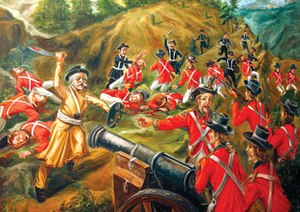Gurkha War
| Anglo-Nepalese War | |||||||
|---|---|---|---|---|---|---|---|
 Bhakti Thapa (in yellow) leading Nepali soldiers at the grand old age of 74 at Anglo-Nepalese War |
|||||||
|
|||||||
| Belligerents | |||||||
|
|
|
||||||
| Commanders and leaders | |||||||
|
|
|
||||||
| Strength | |||||||
|
22,000 men, |
a little more than 11,000 | ||||||
| Casualties and losses | |||||||
| Unknown, presumed to be extremely heavy | Unknown | ||||||
East India Company victory
22,000 men,
with sixty cannon (First campaign) 17,000 (Second campaign)
The Anglo-Nepalese War (1814–16), also known as the Gurkha War, was fought between the Kingdom of Nepal (present-day Nepal) and the East India Company as a result of border disputes and ambitious expansionism of both the belligerent parties. The war ended with the signing of the Treaty of Sugauli in 1816, which ceded around a third of Nepal's territory to the British.
The British were the invading forces, while the Nepalese maintained a defensive position. The British attacked in two successive waves of invasion. It was the most expensive war waged during the governorship of Lord Moira.
The Shah era of Nepal began with the Gorkha king Prithvi Narayan Shah invading Kathmandu valley, which consisted of the capital of the Malla confederacy. Until that time only the Kathmandu valley was referred to as Nepal. The confederacy requested the East India Company for help and an ill-equipped and ill-prepared expedition numbering 2,500 was led by Captain Kinloch in 1767. The expedition was a disaster; the Gorkhali army easily overpowered those who had not succumbed to malaria or desertion. This ineffectual British force provided the Gorkhali with firearms and filled the Gorkhas with overconfidence, causing them to underestimate their opponents in future wars.
Victory and occupation of the Kathmandu Valley by Prithvi Narayan Shah, starting with the Battle of Kirtipur, resulted in the shift of the capital of his kingdom from Gorkha to Kathmandu, and subsequently the empire that he and his descendents built came to be known as Nepal. Also, the invasion of the wealthy Kathmandu Valley provided the Gorkha army with economic support for furthering their martial ambitions throughout the region. The campaign in the eastern region was largely a failure. After a number of defeats to the Limbuwan army, the Gorkha army finally made a peace treaty with Limbuwan and incorporated the Limbuwan states into the kingdom under a mutual pact. In the west, all rulers as far as the Kali River had submitted or been replaced by 1790. Farther west still, the Kumaon Kingdom with its capital Almora also lost the war with the Gorkhali in 1791 under Bahadur Shah, the second son of Prithvi Narayan Shah.
...
Wikipedia
